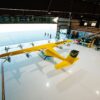Gold Fields Limited (NYSE: GFI) has turned its eyes to the stars by integrating space technology into its exploration and development strategies, and particularly in its Salars Norte project in northern Chile.
The company announced a partnership with Australian space exploration company, Fleet Space Technologies, on Thursday, to deploy its ExoSphere solution.
Gold Fields is using advanced mineral exploration solutions to provide detailed 3D subsurface imaging of the Brecha Principal and Agua Amarga resource areas, potentially revealing new insights into the mineral system.
Situated on the Maricunga Belt in the Andes Mountains, the Salares Norte project presents challenges due to its remote location and extreme weather. With an altitude of 3,900–4,700m above sea level, the project demands innovative exploration approaches. The deployment of ExoSphere technology continues Gold Fields’ strategy to leverage advanced solutions, following the first gold pour in March 2024.
Gold Fields adopted ExoSphere at Salares Norte after achieving positive results at its St. Ives operation in Australia. The technology’s near-zero surface impact and the efficiency of its smart seismic sensors, known as Geodes, make it an environmentally friendly choice for fast 3D subsurface imaging.
“In the field of mineral exploration, ExoSphere has delivered the world’s largest real-time ANT [Ambient Noise Tomography] survey in Australia’s Macquarie Arc and now the world’s highest real-time ANT survey on Chile’s Maricunga Belt – radically scaling the mining industry’s capacity to enhance mineral systems knowledge of remote opportunity zones across vast distances and at unprecedented altitudes, while minimising environmental impact,” said Flavia Tata Nardini, Fleet Space’s CEO.
Read more: Gold is at a crossroads: World Gold Council report
Read more: Calibre Mining strikes gold: new high-grade discovery at Nicaragua’s Limon Mine
Satellites provide detailed views of the subsurface
Gold Fields is adopting space technology in mining to achieve multiple objectives.
By using satellites, the company gains a broader and more detailed view of the subsurface, which increases efficiency and precision while potentially reducing the time and costs associated with traditional ground-based exploration methods.
This approach also minimizes the need for invasive exploration techniques, helping to reduce the environmental footprint of mining operations and aligning with modern expectations for sustainable practices.
Additionally, the use of AI and 3D imaging from ExoSphere facilitates data-driven decisions, which can lead to higher success rates in identifying viable mineral deposits.
Furthermore, the company’s venture into using space technology isn’t just about immediate mineral discovery. It’s part of a broader strategy to position the company as a leader in tech-driven mining. This approach could set a precedent for how mining companies worldwide might operate in the future, combining terrestrial mining with space technology for enhanced exploration capabilities.
The initial investment in such technologies can be high, but long-term gains in efficiency and discovery may offset these costs. Merging space technology with traditional mining operations requires the workforce to develop new skill sets or collaborate with tech firms.
Consequently, the vast amount of data generated necessitates sophisticated analysis, which demands advanced AI and geoscientific interpretation skills.
.
Follow Joseph Morton on Twitter
joseph@mugglehead.com













